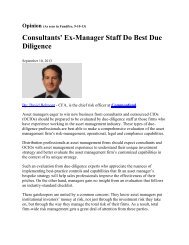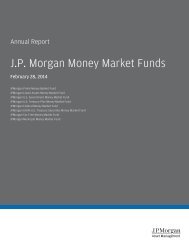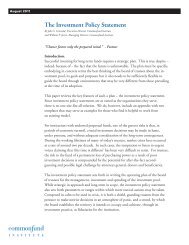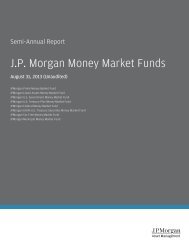Principles of Nonprofit Investment Management - Commonfund
Principles of Nonprofit Investment Management - Commonfund
Principles of Nonprofit Investment Management - Commonfund
You also want an ePaper? Increase the reach of your titles
YUMPU automatically turns print PDFs into web optimized ePapers that Google loves.
Risk <strong>Management</strong>Because so much is at stake, a governingboard must give the subject <strong>of</strong> riska permanent place on its agenda. Ifand when losses occur, those involvedmight well wonder if they could havebeen avoided. The answer is <strong>of</strong>ten yes,if the question had been asked beforethe losses happened.To make sure the right questions areasked at the right time, a systematicapproach to risk must be built into anonpr<strong>of</strong>it’s investing process.In the dictionary sense, “risk” is simply“the possibility <strong>of</strong> harm or loss.” In theinvesting arena, risk commonly refersto the effect <strong>of</strong> market volatility andthe possibility that the investor mayhave to sell when valuations are down.But for a nonpr<strong>of</strong>it, risk has broadersignificance.A nonpr<strong>of</strong>it’s investment risk meansthe possible failure to meet its commitmentsto beneficiaries. Think <strong>of</strong> it asthe failure to earn a sufficient return tocover this year’s distribution requirementor the intended transfer to theoperating budget. But the risks do notstop there. Failures can occur in anypart <strong>of</strong> the investment process, internalor external – in operations, in the safekeepingand accounting <strong>of</strong> assets, inlegal or regulatory issues, in outrightfraud. Any such failure could reverberatefor generations.In the investment industry, theresponse to this challenge is a specificrisk management discipline. Whilethe board must lead in this effort, theresponsibility must become pervasivethrough the investment system.Ideally, it becomes ingrained in theorganization’s culture.The practice <strong>of</strong> risk management startsby identifying every possible reasonwhy the nonpr<strong>of</strong>it might fail to achieveits objectives. The board, the staff, andall relevant outside sources must besensitive to the “galaxy <strong>of</strong> risks” thattheir decisions and actions mightentail. All possibilities for failure mustbe evaluated and controls put in place.It’s difficult because it’s contrary to ournatural inclination toward optimism,our reluctance to think the unthinkableor ever appear negative.A matrix approach has proved effectivefor us at <strong>Commonfund</strong>; it helps promotethe needed discipline. The investmentprocess is divided into specificsteps. For each step you enter everyrisk you and your team can think <strong>of</strong>.The listed risks must be evaluated fordegree <strong>of</strong> possibility and seriousness <strong>of</strong>consequences. For each prioritized risk,you consider possible alternatives, controls,or defenses. And then make surethe controls are put in place andregularly monitored.With the matrix as your base, youcontinually recycle this process, seekingto sharpen and enlarge the matrix. Itrequires taking a skeptical attitude andasking tough questions, such as:◆ In whose name are the assets in ourportfolio being held?◆ Where are the securities being held?◆ Is the valuation accurate?◆ Are we applying all the resourcesactually needed to manageeffectively?◆ What are the laws and regulationsfor compliance?◆ Who is responsible for compliance?◆ What makes us sure we can trust ourinvestment managers and our otherproviders?One overriding question runs throughoutthe process: “What can go wrong?”And everyone involved should keepasking it.An emotionally difficult and potentiallycontroversial process like thiscan quickly peter out if it does nothave visible support from the top.An experienced risk manager withappropriate authority is essential.So is the outspoken agreement <strong>of</strong> theboard. If the board or staff does notseem to have the wherewithal for anintegrated risk management program,you may need consultative supportto get you started.- 25 -













